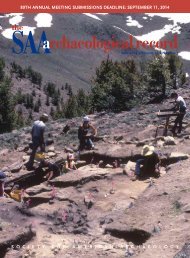SAA
SAA_Record_Nov2015
SAA_Record_Nov2015
You also want an ePaper? Increase the reach of your titles
YUMPU automatically turns print PDFs into web optimized ePapers that Google loves.
PROS AND CONS OF CONSULTING COLLECTORS<br />
to archaeology over the years. I hope to illustrate how a collector’s<br />
enthusiasm, when properly channeled, can add to the<br />
preservation of archaeological sites and materials and contribute<br />
to a better understanding of the prehistory we all enjoy.<br />
Beginning in early high school, I first became involved in<br />
archaeology through the Oklahoma Anthropological Society<br />
(OAS), after discovering a few artifacts near my home that<br />
piqued my interest. Still too young to drive, I went to their<br />
spring meeting in 1971 with my dad, and my life has never<br />
been the same! There I met the likeable Dr. Robert E. Bell,<br />
founder of the society, as well as the State Archaeologist, Dr.<br />
Don Wyckoff. At this meeting, my thirst for information about<br />
the prehistory of Oklahoma was sparked, leading to a seemingly<br />
endless quest for knowledge that persists to this day.<br />
Figure 1. The author, coated in red ochre, screening at the Powars II red<br />
ochre mine site in Wyoming in summer 2015.<br />
Folsom camp in the Black Forest area of Colorado (Hofman<br />
et al. 2001); Dick Eckles’s Northern Kansas Clovis locality<br />
(Holen 2010); Carl Yahnig’s (2009) “Little River Clovis Complex”;<br />
and Clarence H. Webb’s seminal Poverty Point volume<br />
(Ford and Webb 1956; for more on Webb, see Robert Connolly’s<br />
essay in this issue of The <strong>SAA</strong> Archaeological Record).<br />
Recently, a highly significant Paleoindian site in eastern<br />
Wyoming that was itself first reported by amateur Wayne<br />
Powars needed funding for salvage operations. At the urging<br />
of George Frison, Dennis Stanford, and George Ziemans, the<br />
first four individuals to step up to the plate and donate money<br />
to fund this endeavor were collectors. A physician, a veterinarian,<br />
an attorney, and I contributed enough money to<br />
jump-start excavations in June 2014. This site, the Powars II<br />
Red Ocher Mine (Stafford et al. 2003), is the only Paleoindian<br />
ochre mine in North America and one of only two known in<br />
the Americas more broadly. The original four of the “Wild<br />
Bunch,” as Ziemans dubbed us, have also assisted in the<br />
excavations (Figure 1). Thus far, over a thousand artifacts<br />
have been uncovered through largely volunteer efforts. Tools,<br />
weapons, and possibly bone and antler rods of the Clovis culture<br />
have been uncovered, as have artifacts dating to Goshen,<br />
Folsom, Midland, Agate Basin, Hell Gap, and possibly Alberta<br />
periods. We are all extremely proud to have participated in<br />
bringing to fruition the study of this very special site.<br />
At the risk of “tooting my own horn,” I would like to share a<br />
few examples of how I, as an avocationalist, have contributed<br />
Also in 1971, I went to my first archaeological excavation<br />
sponsored by the OAS. There I met like-minded volunteers<br />
working with Don Wyckoff. I also encountered Jack Hofman,<br />
then a high school student like me who has since been<br />
a lifelong friend. Building on these positive relationships, I<br />
have been involved with the society for 45 years, serving on<br />
its Board of Directors for a time. More recently, I helped<br />
found the Archaeological Society of Oklahoma, serving as<br />
president and in other offices.<br />
During the past nearly half-century, I have discovered well<br />
over 500 archaeological sites and recorded many of them<br />
with the University of Oklahoma’s Oklahoma Archaeological<br />
Survey. Many of these sites have been salvaged through excavation<br />
and published. I have accumulated one of the largest<br />
and best-documented private collections from Oklahoma. It<br />
has been made available and studied, and parts have been<br />
published by a number of graduate students working on<br />
their theses and dissertations. A portion of this collection has<br />
already been donated to the Sam Noble Museum of Natural<br />
History in Norman, Oklahoma, and is on display there now.<br />
This facility is the ultimate destination for the bulk of my<br />
lifetime collection.<br />
I have also published a number of papers on various archaeological<br />
topics. Most of these deal with various Paleoindian<br />
studies, sites, and materials. Some of my publications focus<br />
on materials recovered from the famous Spiro Mound here in<br />
Oklahoma. Currently, I am involved in assisting Dr. Don<br />
Wyckoff in his forthcoming synthesis of the Calf Creek culture<br />
across a multi-state region. I will have the privilege of writing<br />
a portion of this study, which I consider Don Wyckoff’s opus,<br />
on collections recovered from sites in central, western, and<br />
southern Oklahoma. My young archaeologist daughter, Claire<br />
Cox, a graduate of Oklahoma University’s anthropology program,<br />
is also helping with this worthwhile project.<br />
In addition to writing, I have presented scholarly papers at several<br />
archaeological conferences. In September 2013 in Love-<br />
18 The <strong>SAA</strong> Archaeological Record • November 2015




